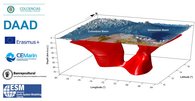3D gravity and thermal models of the Caribbean and northern South American plates
Contribution to POF IV: Topics 3 'Geohazards' and 8 'Georesources'
The Caribbean plate originated in Early Cretaceous time due to the interaction of the Farallon lithosphere with a mantle plume, probably associated with the present-day Galápagos hot spot. This particular interaction gave as a result the Caribbean Large Igneous Plateau (CLIP), a complex lithospheric structure consisting of several stages of spilled basalts flows and underplated ultramafic cumulates. During the migration of the proto-Caribbean (Farallon) plate, accreted fragments were left behind along the northwest and north of the South American margin.

In this project, we used high-resolution satellite gravity measurements to have new insights on the lithospheric configuration in this challenging large domain, where access to direct geophysical data is limited. Here, we integrated up-to-date, worldwide geophysical datasets to account for the thickness of the continental and oceanic sediments, the crystalline crust, the Moho depths, and the density structure of the lithospheric mantle, using tomographic models, and also considering the Nazca and the Caribbean slabs geometries.
Additionally, we used the gravity-validated lithospheric configuration to explore the thermal configuration of the uppermost 75 km of the lithosphere. Assuming a steady-state approach, we aimed to understand potential geohazards, such as the temperature at which earthquakes nucleate and the potential gas hydrate stability zones along the continental margins of the study area.
Ongoing work is focusing on building a 3D lithospheric-scale rheological model, that will provide further understanding on the present-day lithospheric strength and its relation with seismicity. Furthermore, transient thermal experiments will allow us to explore the effect that different global warming scenarios have on the gas hydrate stability conditions.
Partners:
- Prof. Gaspar Monsalve Mejía, Universidad Nacional de Colombia, Sede Medellín
- Prof. Gladys Bernal Franco, Universidad Nacional de Colombia, Sede Medellín
- Dr. Álvaro González Gómez, CRM Barcelona.
- Prof. Eline Le Breton, Freie Universität, Berlin
- Prof. Anne Bernhardt, Freie Universität, Berlin
Funders:
- COLCIENCIAS
- DAAD
- CEMarin
- Fundación para la promoción de la investigación y la tecnología
- Erasmus +
- Advanced Earth System Modelling Capacity (ESM)
Publications:
Gómez-García, Á. M., Le Breton, E., Scheck-Wenderoth, M., Monsalve, G., and Anikiev, D.: The preserved plume of the Caribbean Large Igneous Plateau revealed by 3D data-integrative models, Solid Earth Discuss., https://doi.org/10.5194/se-2020-153, in review, 2020.
Gómez-García, Ángela María. New insights from satellite gravimetry and thermal modelling on the oceanic lithospheric structure: the Caribbean plate as a case study. PhD thesis. Universidad Nacional de Colombia. https://repositorio.unal.edu.co/handle/unal/78490. 2020.
Gómez-García, Á. M., Meeßen, C., Scheck-Wenderoth, M., Monsalve, G., Bott, J., Bernhardt, A., and Bernal, G. 3-D modeling of vertical gravity gradients and the delimitation of tectonic boundaries: The Caribbean oceanic domain as a case study. Geochemistry, Geophysics, Geosystems, 20, 5371–5393. https://doi.org/10.1029/2019GC008340. 2019.
Gómez-García, A.M., Meeßen, C., Scheck-Wenderoth, M., Monsalve, G., Sippel, J., Bernhardt, A., Bernal, G. Average crustal densities and main terrain boundaries of the Caribbean oceanic domain inferred from the modelling of Vertical Gravity Gradients. GFZ Data Services. http://doi.org/10.5880/GFZ.4.5.2019.001. 2019.
Gómez-García, A.M., Meeßen, C., Scheck-Wenderoth, M., Monsalve, G., Sippel, J., Bernhardt, A., Bernal, G. Scripts to calculate the Vertical Gravity Gradients response of a 3D lithospheric model using spherical coordinates: the Caribbean oceanic domain as a case study. GFZ Data Services. http://doi.org/10.5880/GFZ.4.5.2019.002. 2019.



